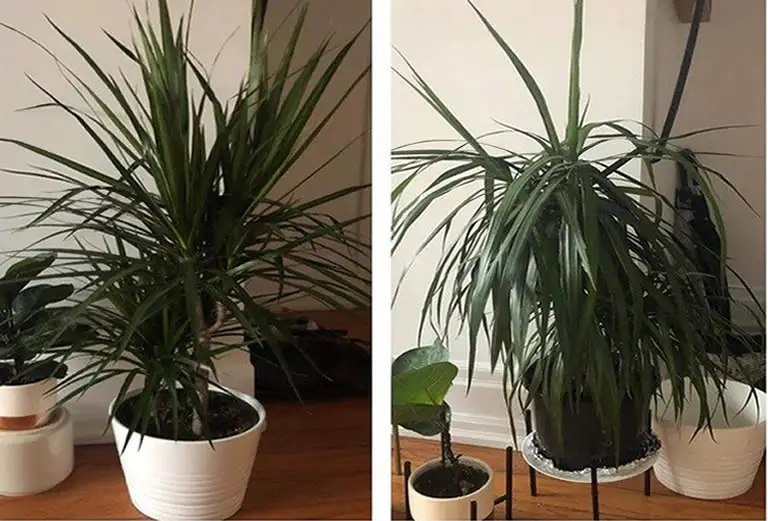Dracaena belongs to the plant family Asparagaceae and is an easy-care succulent, but when you get even an easy-care routine wrong your plant can suffer. In all my years tending to garden plants and houseplants, when it comes to dracaena there are only six basic causes for a drooping plant.
In this article I cover all 6 potential reasons for drooping leaves on a dracaena and how to fix them.
Table of Contents
- The 6 Causes for dracaena leaves problems (drooping, yellowing & browning)
- How to identify the specific cause for your drooping dracaena
- How to save a drooping dracaena
- How to fix drooping dracaena leaves caused by an improper watering routine
- How to fix drooping dracaena leaves caused by tangled/bound roots
- How to fix drooping dracaena leaves caused by incorrect light
- How to fix drooping dracaena leaves caused by incorrect temperatures or temp fluctuations
- How to fix drooping dracaena leaves caused by disease
- How to fix drooping dracaena leaves caused by pest infestation
- What to do when a dracaena starts drooping after repotting
- Causes for a dracaena leaning
The 6 Causes for dracaena leaves problems (drooping, yellowing & browning)
In all my years tending to garden plants and houseplants, when it comes to dracaena 99% of the time there is just one cause for a drooping plant.
However, you should check all 6 potential causes just in case your plant is sufferings from more than one.
In this article I highlight all 6 potential reasons for drooping leaves on a dracaena.
A dracaena is a tropical succulent that has specific care needs that differ slightly from many common succulent houseplants.
Although this is an easy-care plant you must give the plant its basic needs if you want it to grow tall and healthy.
Easy-care does not mean you can neglect it.
When it comes to drooping a dracaena the cause will, more often than not (in fact, the vast majority of times), be linked to either the plant’s watering routine or the amount and type of light it is receiving.
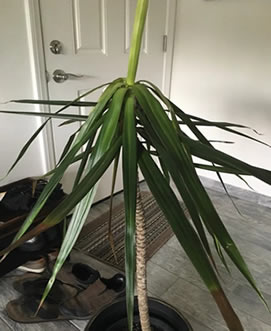
I will cover both these causes in detail later.
However, in some instances a dracaena can droop for other reasons and so I will will also cover these.
For now let’s quickly look at the 6 potential causes for a drooping dracaena.
6 potential causes for dracaena leaves drooping:
- Poor watering routine.
- The plant is root bound.
- Incorrect light.
- Incorrect temperature.
- Disease.
- Pests.
I will cover each of these potential causes in detail now.
In each section below I show you how to identify which one of the above problems is causing your dracaena to droop.
I then give you the fix so that you can get your succulent back to full health as quickly as possible.
How to identify the specific cause for your drooping dracaena
The main question I get asked about sickly dracaena is “why is my dracaena drooping?”, mainly due to the fact that this is one of the first signs the plant displays when it has a problem.,
Thus this is one the most common problems encountered.
So what causes that drooping?
Your dracaena is drooping due to 1 or more of the following reasons: a poor watering routine; roots that have outgrown the container; incorrect light; incorrect temperature; disease; pests.
Once the exact cause has been determined you can take steps to treat the plant to bring it back to full health.
Below are the fixes for each of the 6 causes behind drooping of a dracaena.
How to save a drooping dracaena
Let’s discuss the cures for a drooping dracaena.
To save a drooping dracaena you must first identify which of the 6 potential causes is responsible.
Then you can apply the correct treatment.
The 6 causes are a poor watering routine; roots that have outgrown the container; incorrect light; incorrect temperature; disease; pests.
The first step to saving a drooping dracaena lie sin properly identifying the cause.
Let’s look at how you can do that now.
How to fix drooping dracaena leaves caused by an improper watering routine
In all my years tending to plants, when it comes to dracaena, I have found that drooping foliage is, more often than not, connected to an incorrect watering routine.
As a succulent dracaena requires much less watering than the vast majority of houseplants as it will store water in its leaves for use over a long period.
This makes the plant drought-resistant. However, that doesn’t mean it can survive without water.
Both underwatering and overwatering can cause a dracaena to droop. Though, by far, the most common cause is overwatering.
On average a dracaena can go without water for about 3 weeks.
After 3 weeks, if the plant is not given water, it will start to show signs of dehydration.
This will manifest itself as drooping foliage which will probably also be accompanied by yellow leaves.
If you have been waiting longer than 3 weeks to water your dracaena then the plant is almost certainly dehydrated and in need of a good long drink of water.
Dracaena should always be watered when the top 1 1⁄2″ of soil becomes dry.
Leaving it without water for longer than this can cause the plant to become very dehydrated and droop.
Although dehydration from underwatering will cause drooping it is much more common to see dropping due to overwatering.
Why?
Because it is easier to overwater a dracaena than it is to underwater it simply because the plant is drought-resistant.
Succulents do not like to sit in standing water. Standing water causes root rot in succulents.
Overwatering a dracaena will mean you are forcing it to sit in standing water.
Dying dracaena are more often than not suffering from the effects of overwatering.
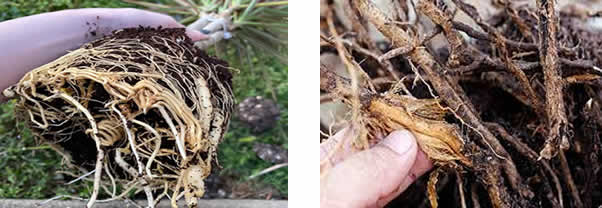
Root rot is exactly what it sounds like – the roots rot and die.
When roots rot they are unable to absorb moisture from the soil and because they cannot absorb water they are unable to distribute it to the rest of the plant.
The plant literally dehydrates in an abundance of water.
Root rot is extremely serious and if not treated quickly will lead to the loss of the plant.
The tell-tale signs of root rot, along with a drooping plant, are mushy areas at the lower parts of the stem.
However, the only way to be sure is to check the roots.
You must remove the plant from its pot, gently brush away soil and dirt from the root ball, and inspect the roots for damage.
Succulent roots naturally tend to look dry because they are a “yellowy” color.
But with many dracaena varieties the roots will actually resemble noodles.
Dead roots will be either black and mushy or very dry and brittle (see image above for comparison).
If you identify root rot in your dracaena then follow the steps outlined in our article dracaena root rot.
You can also read the article about treating aloe vera root rot as the instructions in that article can be applied to treating the same problem in a dracaena.
How to fix drooping dracaena leaves caused by tangled/bound roots
Dracaena do not like to be very root bound.
When the roots outgrow the container the plant is in, the plant will begin to droop.
Although root bound dracaena is one of the lesser causes for a drooping plant I have placed this possible cause high up in the article.
I have done this because you can check the roots while you are checking the plant for root rot.
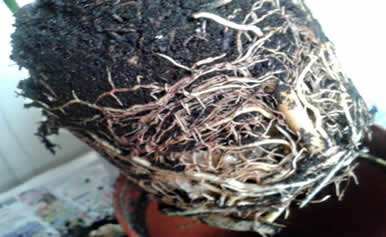
If you find that your dracaena is root bound then you will need to repot it.
You can choose to plant the dracaena in a bigger pot, which will encourage bigger growth of the plant. Or, you can trim the roots and replace it back in its original pot with some fresh soil to maintain the plant’s current size.
How to fix drooping dracaena leaves caused by incorrect light
The second most common cause for a drooping dracaena is incorrect light.
Dracaena can tolerate low light but it is not an ideal environment for this succulent.
Without at least 4 hours of strong indirect per day a dracaena can slow, or even stop, growing as I pointed out in the article about dracaena not growing.
If left in a low light location for long periods a dracaena can begin to droop due to the lack of energy and depleted resources that it can only get from photosynthesis.
At the very least a dracaena needs 4 hours of strong indirect light.
However, I have found that ensuring the plant gets a minimum of 6 hours of strong indirect light per day will help the plant grow faster, taller, bushier and straighter.
If you have placed your dracaena in a dim environment then you should move it somewhere that gets good indirect light.
Use a grow light if you don’t want to move the plant.
Be sure not to place the plant in the path of direct sunlight however. Direct light will damage a dracaena.
We covered all the essential dracaena light requirements in a previous article.
How to fix drooping dracaena leaves caused by incorrect temperatures or temp fluctuations
Dracaena grow the best in temperatures between 65°F – 75°F.
As the average home in kept at a fairly consistent 70°F throughout the year, thanks to HAVC and similar climate control systems, dracaena makes a great houseplant.
However, if the plant is placed in a location that gets sharp changes in temperatures then the plant will react.
Often this reaction will be a drooping of the foliage.
Locations that experience short, but sharp, dips in temperature could include areas beside a door that opens to the outside of the house.
Drafty windows and even fridge and freezer door can cause sudden dips in the temperature.
Locations that experience short, but sharp, rises in temperatures could include areas beside heating vents or strong heat-producing lights.
If you have placed a plant close to an area that gets rises or dips in temperature, no matter how small you think those may be, and the plant is drooping then move it to a more temperature-stable location.
How to fix drooping dracaena leaves caused by disease
Most diseases that will cause a dracaena to drop will be fungal in nature.
Fugal infections have the same symptoms as root rot and require similar treatment.
If the fugus has been allowed to spread throughout the roots and has affected the stems then the plant may be beyond treatment.
However, it is always worth it to try to save the plant and if you stop the infection quickly the damage to the plant may be reversible.
Treat the plant root system as you would for root rot (see section on diagnosing poor watering routine above) and use a good strong fungicide.
Once treated repot the plant in a new pot with fresh soil.
Wash the old pot thoroughly with detergent and dispose of it or, if you really want to use it again be sure to rinse it completely before using it for another plant.
How to fix drooping dracaena leaves caused by pest infestation
Pest infestations can also cause your dracaena to droop.
Common pests, such as aphids and mealybugs, feed on the sap of dracaena.
They drain the plant of resources causing it to droop and fall over, in addition to other causes such as leaf drop and stunted plant growth.
You will see clear signs of pests on the leaves of the plant, usually as colored spots.
Use a good pesticide and watch for signs of root damage.
Pests can often feed lower down the stem of the leaves causing them to fall off.
Once treated you will then have to take steps to regrow the dracaena leaves to get your plant back to the way it looked before the infestation.
What to do when a dracaena starts drooping after repotting
What if your dracaena was perfectly fine until you repotted it but now it is drooping?
If your dracaena has been placed in the same location it was initially growing in, but is drooping after being repotted this is usually a sign that the plant requires water or has been overwatered.
Check the soil for moisture levels to determine if the plant has been underwatered. This is the most likely cause for a normally healthy dracaena drooping after repotting.
See the section directly below this one to determine the moisture levels in the soil and to learn how much water you should give your dracaena after repotting it.
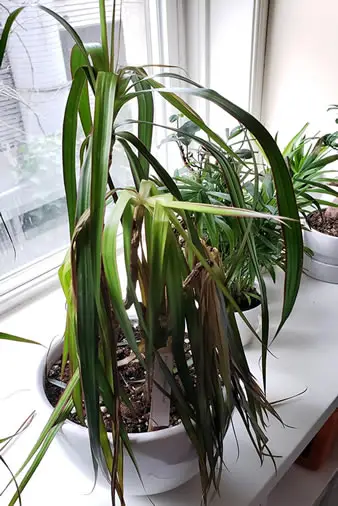
If the plant was repotted due to disease treatment or after being treated for root rot, then the drooping may be a sign of a more serious issue.
You should read the above sections of this article for advice dealing with that problem.
How to avoid dracaena leaves drooping after repotting
With dracaena being a succulent and therefore not requiring a lot of watering you may be wondering when it is ok to water the plant after you have repotted it.
After all we have already seen that too much water can cause a dracaena to droop or even die.
You should water your dracaena after repotting when the top 1 1⁄2 inches of soil dries out.
However, if you have repotted the dracaena in completely dry soil then you can water it immediately.
If the soil was moist when you repotted the plant, wait until the top layer dries out.
I always repot plants in soil that is slightly moist but it is much more common to use bagged houseplant soil.
Store-bought houseplant soil is almost always dry and therefore it is advisable to water your dracaena immediately after repotting it.
Then just continue your normal dracaena watering routine thereafter.
If, like me, you use moist soil for repotting then it is better to wait until the top layer of the soil, about 1 1⁄2 inches deep, has dried out before watering the plant.
Use a cheap moisture meter to check the soil for moisture before watering a dracaena, as overwatering the plant is very common and causes serious problems (as you can see from the above sections).
Causes for a dracaena leaning
Drooping is not the only problem dracaena houseplant owners experience. Many times a dracaena plant will lean to the side.
What is your dracaena leaning?
Your dracaena is likely leaning to get more light. Plants lean towards the nearest light source when they are not getting enough light.
Although dracaena can grow in low light I have found that this succulent needs at least 6 hours of strong indirect light per day to grow tall and straight.
If your dracaena is leaning to one side it is a sure sign that the plant is not getting enough light. You must move it to a brighter location.
Be aware though that you should never place a dracaena somewhere that gets direct sunlight.
Aim for approximately 6 hours of good strong indirect light, or good strong shaded light, every day.
Ensure the entire area is equally well-lit and that there is not more light at one side of the plant than the other. Over time the plant will straighten again.
You may also be interested in our article how to root dracaena about propagating a new plant.
Remember though before you cultivate and grow this succulent that dracaena is it poisonous to some pets and this applies to the popular dragon tree.

